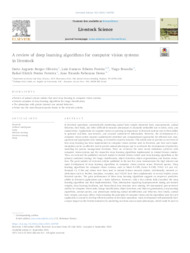A review of deep learning algorithms for computer vision systems in livestock.
A review of deep learning algorithms for computer vision systems in livestock.
Autoria: OLIVEIRA, D. A. B.; PEREIRA, L. G. R.; BRESOLIN, T.; FERREIRA, R. E. P.; DREA, J. R. R.
Resumo: In livestock operations, systematically monitoring animal body weight, bio-metric body measurements, animal behavior, feed bunk, and other difficult-to-measure phenotypes is manually unfeasible due to labor, costs, and animal stress. Applications of computer vision are growing in importance in livestock systems due to their ability to generate real-time, non-invasive, and accurate animal-level information. However, the development of a computer vision system requires sophisticated statistical and computational approaches for efficient data management and appropriate data mining, as it involves mas-sive datasets. This article aims to provide an overview of how deep learning has been implemented in computer vision systems used in livestock, and how such implementation can be an effective tool to predict animal phe-notypes and to accelerate the development of predictive modeling for precise management decisions. First, we reviewed the most recent milestones achieved with computer vision systems and its respective deep learning algorithms implemented in Animal Science studies. Second, we reviewed the published research studies in Animal Science, which used deep learning algorithms as the primary analytical strategy for image classification, object detection, object segmentation, and feature extraction. The great number of reviewed articles published in the last few years demonstrates the high interest and rapid development of deep learning algorithms in computer vision systems across livestock species. Deep learning algorithms for computer vision systems, such as Mask R-CNN, Faster R-CNN, YOLO (v3 and v4), DeepLab v3, U-Net and others have been used in Animal Science research studies. Additionally, network architectures such as ResNet, Inception, Xception, and VGG16 have been implemented in several studies across livestock species. The great performance of these deep learning algorithms suggests an33improved predictive ability in livestock applications and a faster inference.34However, only a few articles fully described the deep learning algorithms and its implementation. Thus, information regarding hyperparameter tuning, pre-trained weights, deep learning backbone, and hierarchical data structure were missed. We summarized peer-reviewed articles by computer vision tasks38(image classification, object detection, and object segmentation), deep learn-39ing algorithms, species, and phenotypes including animal identification and behavior, feed intake, animal body weight, and many others. Understanding the principles of computer vision and the algorithms used for each application is crucial to develop efficient systems in livestock operations. Such development will potentially have a major impact on the livestock industry by predicting real-time and accurate phenotypes, which could be used in the future to improve farm management decisions, breeding programs through high-throughput phenotyping, and optimized data-driven interventions.
Ano de publicação: 2021
Tipo de publicação: Artigo de periódico
Unidade: Embrapa Gado de Leite
Palavras-chave: Agricultura de Precisão, Artificial intelligence, Gado, Inteligência artificial, Machine learning, Suíno
Observações
1 - Por padrão são exibidas publicações dos últimos 20 anos. Para encontrar publicações mais antigas, configure o filtro ano de publicação, colocando o ano a partir do qual você deseja encontrar publicações. O filtro está na coluna da esquerda na busca acima.
2 - Para ler algumas publicações da Embrapa (apenas as que estão em formato ePub), é necessário ter, no celular ou computador, um desses softwares gratuitos. Sistemas Android: Google Play Livros; IOS: iBooks; Windows e Linux: software Calibre.
Acesse outras publicações
Acesse a Base de Dados da Pesquisa Agropecuária (BDPA) para consultar o acervo completo das bibliotecas da Embrapa.

